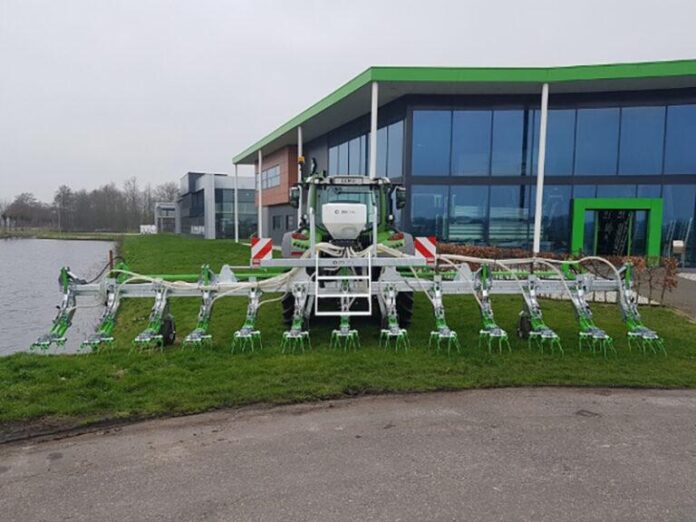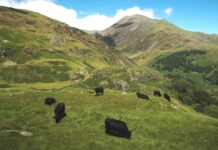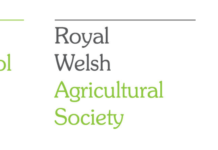There is nothing extraordinary about the sight of sheep grazing on a West Wales farm, but for contractor James George is it is the latest example of the positive impact under sowing can make for the farmer and the environment.
James and his father, of Rhodri George Agri Contracting & Liquid Fertiliser at Hayscastle near Haverfordwest in Pembrokeshire, bought a Zocon Greenseeder to enable catch crops to be under sown in maize and worked on 750 acres last year with the system.
Part of that under sowing was a Farming Connect trial for grass between the rows of maize which is where the sheep come into the equation. James explained:” We did a trial plot just outside Haverfordwest and the farmer said he had 16 days’ worth of grazing for 160 ewes in a 16 acre field and they are going back on shortly.
“Most people have put sheep on the under sown grass through the winter and there are real benefits having them on it.
“We did about 750 acres last year and the system holds all the soil together to stop any runoff. Also, besides the winter sheep grazing you potentially have silage in April-May. Other people grew different types of feed such as clover for the benefit of the soil to put proteins into it. If there is any nitrogen left in the soil the grass is using that during the winter and so that isn’t lost into the rivers.”
The target period for sowing a cover crop into maize is from one week after the last herbicide was applied, with maize plants at the six- or seven-leaf stage to prevent them being smothered by the grass
The George’s Greenseeder – an 8 row on 75cm – was bought in 2022 and besides increasing feed for sheep, under sowing has delivered environmental benefits including limiting winter soil erosion and nutrient loss. Initially, what James admitted was a gamble has become a series of positives that have resonated with fellow farmers.
James explained: “I was looking at another type of drill of three lines in between the maize crop and then my uncle saw this Greenseeder and believed there were more benefits from this machine and, to be fair, he was right.
“At first, some people couldn’t get the concept but others wanted to try it. This could have backfired but it has worked.
“Potentially, we could be ahead of the game and the results we have seen from the system have been fantastic and, hopefully, we will pick up more work. It was a big gamble because no one had done it down here and it has worked.
“People can see it has been a success because if you don’t under sow then it could be six months of bare soil. The farmers who have under sown have found that there is a place to put the slurry because it won’t run off the grass which binds it together and holds it rather than it ending up in the rivers.”
Reducing the amount of run off into water courses and keeping mud off the public roads are just two aspects of under sowing that James highlights as significant benefits of using the system. “In November we walked the trial field and any water that was running on what was a wet day, was clear: “he added.” Whereas if there hadn’t been grass it would have been brown.
“With the runoff problem and loss of nitrates and potential rules and regulations, this kind of work will have to be done or else farmers could be fined or not get their points.
“Come harvest if it is wet – and people noticed that this year- the grass root structure holds together on the under sown areas and trailers do not bring as much mud onto the roads which it made it an easier harvest. “
James insists there are very few negatives involved with a Greenseeder, however, he does point out that sowing in maize requires skill to ensure you do not damage the main crop. He explained: “It is not a machine that is simple to use because you are driving down maize around 18 inches tall – we did go up to 40ins – and you do not want to damage the crop.
“You are driving down rows with little margin for error because if you are damaging the maize then it is a waste of time. You are doing this job as a benefit for the winter and if you are damaging the maize, it is a big loss for the farmer. It needs to be done with accuracy and care.
“There is a lot more talk about this machine and people have been ringing up saying they would like to try the idea for next year and when there are increased rain levels it does become more of a topic of conversation.
“Negatives? To be honest I can’t really think of any although some people feel it may knock the maize yield a little bit. On the whole I don’t think it did and I would say that 95 per cent has worked brilliantly.”
Help keep news FREE for our readers
Supporting your local community newspaper/online news outlet is crucial now more than ever. If you believe in independent journalism, then consider making a valuable contribution by making a one-time or monthly donation. We operate in rural areas where providing unbiased news can be challenging. Read More About Supporting The West Wales Chronicle

























